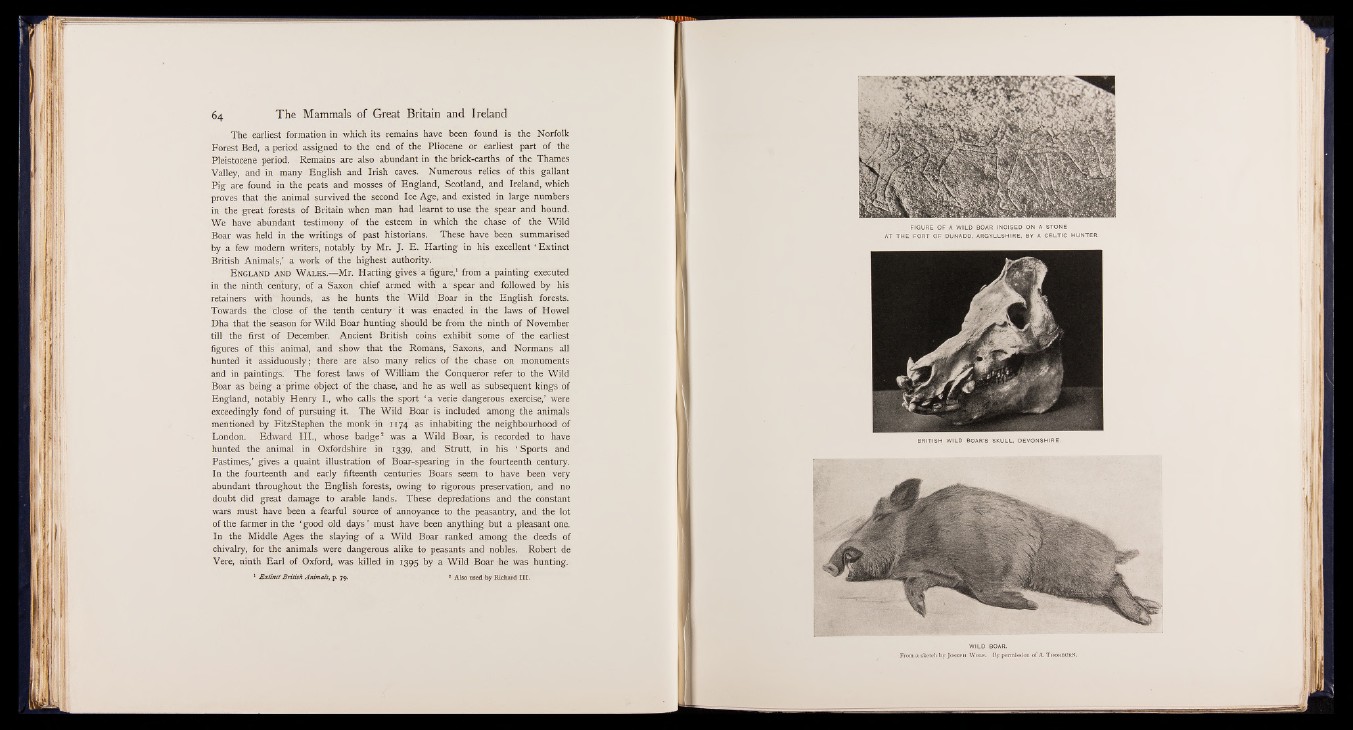
The earliest formation in which its remains have been found is the Norfolk
Forest Bed, a period assigned to the end of the Pliocene or earliest part of the
Pleistocene period. Remains are also abundant in the brick-earths of the Thames
Valley, and in many English and Irish caves. Numerous relics of this gallant
Pig are found in the peats and mosses of England, Scotland, and Ireland, which
proves that the animal survived the second Ice Age, and existed in large numbers
in the great forests of Britain when man had learnt to use the spear and hound.
We have abundant testimony of the esteem in which the chase of the Wild
Boar was held in the writings of past historians. These have been summarised
by a few modern writers, notably by Mr. J. E. Harting in his excellent ‘ Extinct
British Animals,’ a work of the highest authority.
E n g l a n d a n d W a l e s .— Mr. Harting gives a figure,1 from a painting executed
in the ninth century, of a Saxon chief armed with a spear and followed by his
retainers with hounds, as he hunts the Wild Boar in the English forests.
Towards the close of the tenth century it was enacted in the laws of Howel
Dha that the season for Wild Boar hunting should be from the ninth of November
till the first of December. Ancient British coins exhibit some of the earliest
figures of this animal, and show that the Romans, Saxons, and Normans all
hunted it assiduously; there are also many relics of the chase on monuments
and in paintings: The forest laws of William the Conqueror refer to the Wild
Boar as being a prime object of the chase, and he as weir as subsequent kings of
England, notably Henry I., who calls the sport ‘ a verie dangerous exercise,’ were
exceedingly fond of pursuing it. The Wild Boar is included among the animals
mentioned by FitzStephen the monk in 1174 as inhabiting the neighbourhood of
London. Edward III., whose badge2 was a Wild Boar, is recorded to have
hunted the animal in Oxfordshire in 1339, and Strutt, in his ‘ Sports and
Pastimes,’ gives a quaint illustration of Boar-spearing in the fourteenth century.
In the fourteenth and early fifteenth centuries Boars seem to have been very
abundant throughout the English forests, owing to rigorous preservation, and no
doubt did great damage to arable lands. These depredations and the constant
wars must have been a fearful source of annoyance to the peasantry, and the lot
of the farmer in the ‘ good old days’ must have been anything but a pleasant one.
In the Middle Ages the slaying of a Wild Boar ranked among the deeds of
chivalry, for the animals were dangerous alike to peasants and nobles. Robert de
Vere, ninth Earl of Oxford, was killed in 1395 by a Wild Boar he was hunting.
Extinct British Animals, p. 79. * Also used by Richard III.
WILD BOAR.
From a sketch by Joseph Wolf. By permission of A. Thorburn.